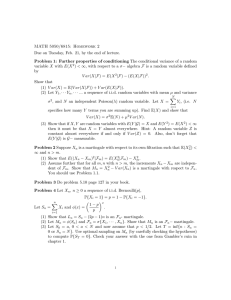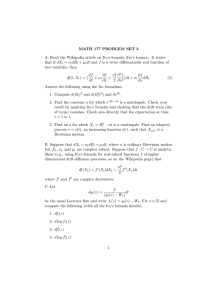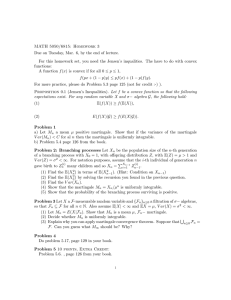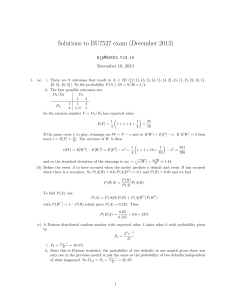Remark on writing down an SDE
advertisement
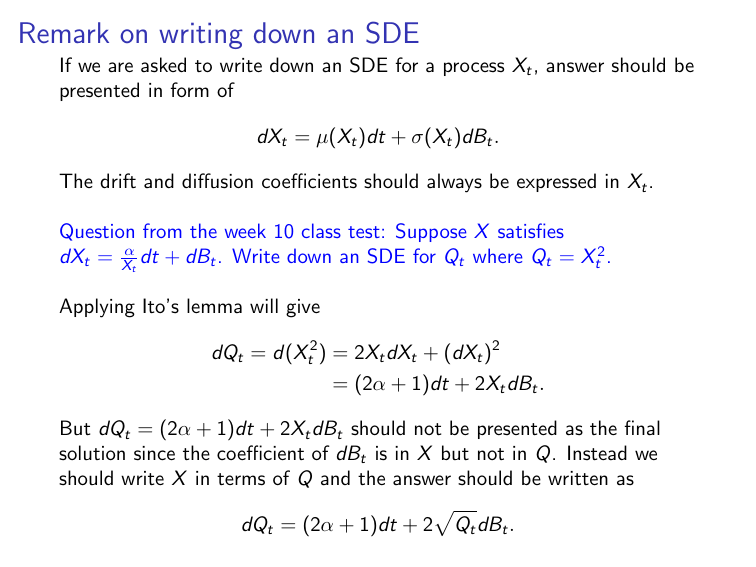
Remark on writing down an SDE If we are asked to write down an SDE for a process Xt , answer should be presented in form of dXt = µ(Xt )dt + σ(Xt )dBt . The drift and diffusion coefficients should always be expressed in Xt . Question from the week 10 class test: Suppose X satisfies dXt = Xαt dt + dBt . Write down an SDE for Qt where Qt = Xt2 . Applying Ito’s lemma will give dQt = d(Xt2 ) = 2Xt dXt + (dXt )2 = (2α + 1)dt + 2Xt dBt . But dQt = (2α + 1)dt + 2Xt dBt should not be presented as the final solution since the coefficient of dBt is in X but not in Q. Instead we should write X in terms of Q and the answer should be written as p dQt = (2α + 1)dt + 2 Qt dBt . (Local) martingale property of a stochastic integral Let X be a martingale, and C be an adapted process. Pn I In discrete time, we know that (C · X )n := k=1 Ck−1 (Xk − Xk−1 ) is a martingale. Rt I As a continuous time analogue, (C · X )t := C dXs is a local 0 s martingale. Rt In the continuous time if we further know that 0 Cs dXs is a true (i.e not just local) martingale, then by the martingale property of E(Mt ) = M0 , Rt we can conclude E( 0 Cs dXs ) = 0. Warning: In general a stochastic integral is not always a true martingale, and hence it may not have zero expectation. In the ST909 module in term 2, you will see some tools which help check whether a local martingale is a true martingale. Stochastic integral (against a Brownian motion) with deterministic integrand In the last part of Q4(B) of the Jan2015 exam paper, it asks about identifying the distribution of Yt where Z t −κt −κt Yt = Y0 e + m(1 − e )+ σe −κ(t−s) dBs . 0 The first two termsR are just constants. Thus it is all about asking what t the distribution of 0 σe −κ(t−s) dBs is. Indeed, this is having a normal R t 2 −2κ(t−s) distribution of N(0, 0 σ e ds) (see the lemma below), and hence Yt is distributed as Z t Yt ∼ N(Y0 e −κt + m(1 − e −κt ), σ 2 e −2κ(t−s) ds)) 0 σ2 −κt −κt −2κt = N Y0 e + m(1 − e ), (1 − e ) . 2κ Lemma If C is a deterministic process, then Rt 0 Cs dBs ∼ N(0, Rt 0 Cs2 ds). Sketch of proof for the lemma Proof. Rt Let f (t) := 0 Cs2 ds, which is a deterministic and increasing function. Let f −1 (t) be the (left-continuous) inverse function of f , which is guaranteed to be well-defined since f is increasing. R f −1 (t) Cs dBs . We first claim that the process (It )t>0 is Also define It := 0 a Brownian motion, since 1. It , as a stochastic integral, is a continuous local martingale; 2. The quadratic variation of I is given by R f −1 (t) 2 [I ]t = 0 Cs ds = f (f −1 (t)) = t. I is then a Brownian motion by Levy’s theorem. Then It ∼ N(0, t) and R f −1 (t) equivalently 0 Cs dBs ∼ N(0, t). On replacing t by f (t), we get Z t Z t Cs dBs ∼ N(0, f (t)) = N(0, Cs2 ds). 0 0
